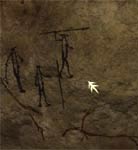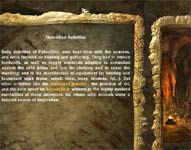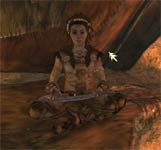Echo Secrets of the Lost Cavern
Brief Description of Echo Secrets of the Lost Cavern
You are Arok, a young Paleolithic hunter. While out trying to kill food for the clan, you are chased into a cave. Once in the cave, you are reminded of Klem a painter that visited your people when you were still small. You decide to find Klem and learn the art of painting.
The game features lovely graphics, interesting music and above average voice acting. It can be described as Edutainment, because of the reference material. Much research into what is known about the Paleolithic era and how the people of that time might have lived. The artwork in the caves you will find is much like art found in Lascaux Cave in France.
The puzzles in the game are primarily of two kinds. The first has to do with prehistoric paintings. Some you need to complete, others you need to manipulate. The second sort of puzzle requires you gather materials and create tools of the type used by prehistoric societies.
Game play and hints
As Arok, you'll need to make tools. Making tools includes finding items that can be made into tools as well as the skills to put them together. So in this game, it is particularly important to examine items on the ground carefully. Rocks, grass, sticks, etc. may all be used to make tools or to build fire. Tools can only be assembled at certain locations (large flat areas) so you'll need to look for those as well.
Arok will need to discover the secrets of a number of paintings. Some of them will magically help him, others demonstrate things he must do. Sometimes they need to painted or sometimes just touched to activate them.
There are a few times when a number of icons appear in the upper right corner as you make a tool or work on a painting. Those represent the allowable number of mistakes Arok has before he must start over. Pay attention as you work on an item and remember what you did that didn't cause an icon to disappear. If you need to restart, you'll know better what to do. Most of these puzzles won't take long to solve once you start doing this.
As you play the game, you may notice either a shell, hand or both icons appearing in the top right of the screen. The shell icon means you've unlocked more of the in game encyclopedia. The hand means you've added something to the journal. It can be a good idea to open the inventory and check these, they may give you a clue as to what to do next.
Having problems with a puzzle? There are a couple of things to try before getting out your handy walkthrough. Check for hot spots, sometimes there may be more than you realise at first. This is particularly true of the rock art, there may well be more things you can do with them. Once you find other people, chatting to them may give you a clue on how to proceed.
Gripes about Echo Secrets of the Lost Cavern
The game can be a bit too sensitive to mouse motion and can make you dizzy from spinning around. Plus there are times when it is far too easy to miss a hot spot, one that makes it possible to complete a puzzle.
Conclusion for Echo Secrets of the Lost Cavern
A refreshing change of pace from the 'find a button, press a button' type mechanical puzzles that are so common. The magic invoked by the cave paintings is quite unique in my experience. As are a number of the puzzles you need to solve in the game.
There are elements to this game that some gamers won't enjoy. One puzzle you have to complete the correct sequence quickly enough. Sometimes you do get down to pixel hunting to ensure you've found everything. The navigation allowing a complete spin in an area isn't for everyone either. In fact, over at Gameboomers you can find a number of posts from people who love and those who loath the game.
I would rate the game as 4 of 5 stars. Quite an enjoyable experience, even if I do wish that the entire game was longer.
Some final thoughts on the game.
I found the puzzles that reset if you do them wrong a bit odd. Mind you, since you need to complete that puzzle to go on, it's either reset or make you restart the game.


